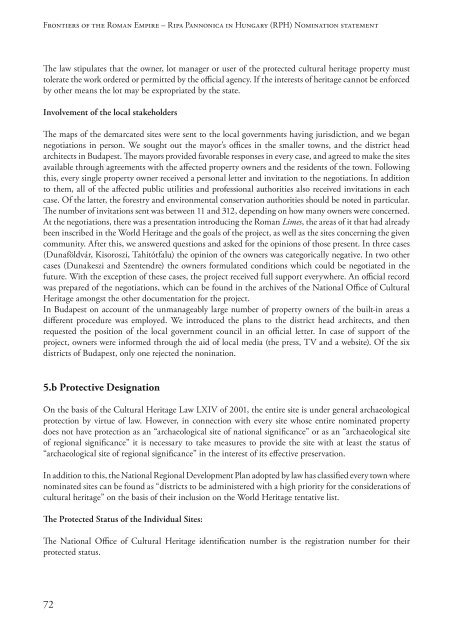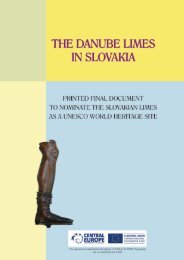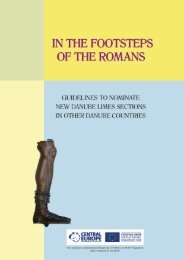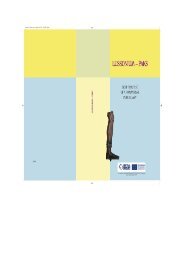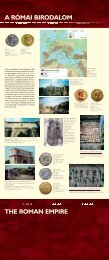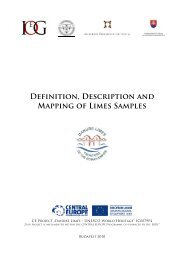the PDF version! - Danube Limes
the PDF version! - Danube Limes
the PDF version! - Danube Limes
You also want an ePaper? Increase the reach of your titles
YUMPU automatically turns print PDFs into web optimized ePapers that Google loves.
Frontiers of <strong>the</strong> Roman Empire – Ripa Pannonica in Hungary (RPH) Nomination statement<br />
The law stipulates that <strong>the</strong> owner, lot manager or user of <strong>the</strong> protected cultural heritage property must<br />
tolerate <strong>the</strong> work ordered or permitted by <strong>the</strong> official agency. If <strong>the</strong> interests of heritage cannot be enforced<br />
by o<strong>the</strong>r means <strong>the</strong> lot may be expropriated by <strong>the</strong> state.<br />
Involvement of <strong>the</strong> local stakeholders<br />
The maps of <strong>the</strong> demarcated sites were sent to <strong>the</strong> local governments having jurisdiction, and we began<br />
negotiations in person. We sought out <strong>the</strong> mayor’s offices in <strong>the</strong> smaller towns, and <strong>the</strong> district head<br />
architects in Budapest. The mayors provided favorable responses in every case, and agreed to make <strong>the</strong> sites<br />
available through agreements with <strong>the</strong> affected property owners and <strong>the</strong> residents of <strong>the</strong> town. Following<br />
this, every single property owner received a personal letter and invitation to <strong>the</strong> negotiations. In addition<br />
to <strong>the</strong>m, all of <strong>the</strong> affected public utilities and professional authorities also received invitations in each<br />
case. Of <strong>the</strong> latter, <strong>the</strong> forestry and environmental conservation authorities should be noted in particular.<br />
The number of invitations sent was between 11 and 312, depending on how many owners were concerned.<br />
At <strong>the</strong> negotiations, <strong>the</strong>re was a presentation introducing <strong>the</strong> Roman <strong>Limes</strong>, <strong>the</strong> areas of it that had already<br />
been inscribed in <strong>the</strong> World Heritage and <strong>the</strong> goals of <strong>the</strong> project, as well as <strong>the</strong> sites concerning <strong>the</strong> given<br />
community. After this, we answered questions and asked for <strong>the</strong> opinions of those present. In three cases<br />
(Dunaföldvár, Kisoroszi, Tahitótfalu) <strong>the</strong> opinion of <strong>the</strong> owners was categorically negative. In two o<strong>the</strong>r<br />
cases (Dunakeszi and Szentendre) <strong>the</strong> owners formulated conditions which could be negotiated in <strong>the</strong><br />
future. With <strong>the</strong> exception of <strong>the</strong>se cases, <strong>the</strong> project received full support everywhere. An official record<br />
was prepared of <strong>the</strong> negotiations, which can be found in <strong>the</strong> archives of <strong>the</strong> National Office of Cultural<br />
Heritage amongst <strong>the</strong> o<strong>the</strong>r documentation for <strong>the</strong> project.<br />
In Budapest on account of <strong>the</strong> unmanageably large number of property owners of <strong>the</strong> built-in areas a<br />
different procedure was employed. We introduced <strong>the</strong> plans to <strong>the</strong> district head architects, and <strong>the</strong>n<br />
requested <strong>the</strong> position of <strong>the</strong> local government council in an official letter. In case of support of <strong>the</strong><br />
project, owners were informed through <strong>the</strong> aid of local media (<strong>the</strong> press, TV and a website). Of <strong>the</strong> six<br />
districts of Budapest, only one rejected <strong>the</strong> nonination.<br />
5.b Protective Designation<br />
On <strong>the</strong> basis of <strong>the</strong> Cultural Heritage Law LXIV of 2001, <strong>the</strong> entire site is under general archaeological<br />
protection by virtue of law. However, in connection with every site whose entire nominated property<br />
does not have protection as an “archaeological site of national significance” or as an “archaeological site<br />
of regional significance” it is necessary to take measures to provide <strong>the</strong> site with at least <strong>the</strong> status of<br />
“archaeological site of regional significance” in <strong>the</strong> interest of its effective preservation.<br />
In addition to this, <strong>the</strong> National Regional Development Plan adopted by law has classified every town where<br />
nominated sites can be found as “districts to be administered with a high priority for <strong>the</strong> considerations of<br />
cultural heritage” on <strong>the</strong> basis of <strong>the</strong>ir inclusion on <strong>the</strong> World Heritage tentative list.<br />
The Protected Status of <strong>the</strong> Individual Sites:<br />
The National Office of Cultural Heritage identification number is <strong>the</strong> registration number for <strong>the</strong>ir<br />
protected status.<br />
72


